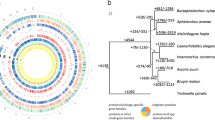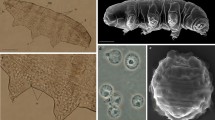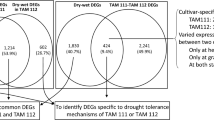Abstract
When subjected to drought conditions, some organisms enter a state of suspended animation known as anhydrobiosis1, surviving for indefinite periods until rehydration allows them to resume normal metabolism. We have identified a gene in the anhydrobiotic nematode Aphelenchus avenae that is upregulated in response to desiccation stress and whose encoded protein shares sequence similarity with a late-embryonic gene that is induced in many plants when they are deprived of water. This finding suggests that animals and plants that undergo anhydrobiosis may use common protective strategies against dehydration, and provides a unifying insight into the mechanism of anhydrobiosis.
This is a preview of subscription content, access via your institution
Access options
Subscribe to this journal
Receive 51 print issues and online access
$199.00 per year
only $3.90 per issue
Buy this article
- Purchase on SpringerLink
- Instant access to full article PDF
Prices may be subject to local taxes which are calculated during checkout

Similar content being viewed by others
References
Crowe, J. H., Hoekstra, F. A. & Crowe, L. M. Annu. Rev. Physiol. 54, 579–599 (1992).
Madin, K. A. C. & Crowe, J. H. J. Exp. Zool. 193, 335–346 (1975).
Crowe, J. H., Carpenter, J. F. & Crowe, L. M. Annu. Rev. Physiol. 60, 73–103 (1998).
Sun, W. Q. & Leopold, A. C. Comp. Biochem. Physiol. 117A, 327–333 (1997).
Higa, L. M. & Womersley, C. Z. J. Exp. Zool. 267, 120–129 (1993).
García de Castro, A. & Tunnacliffe, A. FEBS Lett. 487, 199–202 (2000).
Ingram, J. & Bartels, D. Annu. Rev. Plant Physiol. Plant Mol. Biol. 47, 377–403 (1996).
Dure, L. et al. Plant Mol. Biol. 12, 475–486 (1989).
Dure, L. Plant J. 3, 363–369 (1993).
Wolkers, W. F. et al. Biochem. Biophys. Acta 1544, 196–206 (2001).
Dure, L. Protein Pept. Lett. 8, 115–122 (2001).
Solomon, A., Salomon, R., Paperna, I. & Glazer, I. Parasitology 121, 409–416 (2000).
Author information
Authors and Affiliations
Corresponding author
Ethics declarations
Competing interests
The authors declare no competing financial interests.
Rights and permissions
About this article
Cite this article
Browne, J., Tunnacliffe, A. & Burnell, A. Plant desiccation gene found in a nematode. Nature 416, 38 (2002). https://doi.org/10.1038/416038a
Issue date:
DOI: https://doi.org/10.1038/416038a
This article is cited by
-
LEA motifs promote desiccation tolerance in vivo
BMC Biology (2021)
-
Advanced technologies for the preservation of mammalian biospecimens
Nature Biomedical Engineering (2021)
-
The Aphelenchus avenae genome highlights evolutionary adaptation to desiccation
Communications Biology (2021)
-
Extreme-tolerance mechanisms in meiofaunal organisms: a case study with tardigrades, rotifers and nematodes
Hydrobiologia (2020)
-
Structural properties and cellular expression of AfrLEA6, a group 6 late embryogenesis abundant protein from embryos of Artemia franciscana
Cell Stress and Chaperones (2019)



